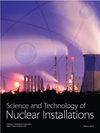基于机器学习的小型模块化反应堆氢经济性评价方法
IF 1
4区 工程技术
Q3 NUCLEAR SCIENCE & TECHNOLOGY
引用次数: 0
摘要
在本研究中,我们评估了使用小型模块化反应器(SMRs)的制氢成本。此外,我们采用基于机器学习的方法来预测影响制氢成本的重要参数。此外,我们使用氢经济评估程序来计算使用两种类型的smr时的制氢成本:由韩国原子能研究所(KAERI)开发的系统集成模块化先进反应堆(SMART)和由NuScale power, LLC开发的NuScale功率模块™(NPM)。选择不同的储存和运输方式,以找到最便宜的选择。使用SMART,将氢气储存在压缩气体中并通过管道(CG-Pipe)运输是最佳选择,估计成本为2.77美元/公斤。使用SMART时的其他选择包括压缩气体储存和车辆运输(CG-Vehicle),估计成本为3.27美元/公斤;液化储存和车辆运输(L-Vehicle),估计成本为3.31美元/公斤;储存在金属氢化物中,用车辆(MH-Vehicle)运输,估计成本为每公斤6.97美元。使用NPM, CG-Pipe是生产氢气最便宜的选择,估计成本为2.95美元/公斤。其他选择包括CG-Vehicle(3.35美元/公斤)、L-Vehicle(3.42美元/公斤)和MH-Vehicle(7.04美元/公斤)。使用SMART制氢比使用NPM更便宜。然而,使用这两种反应器的制氢成本之间的差异并不显著。我们得出的结论是,最优制氢成本为3.27美元/千克(CG-Vehicle)至3.42美元/千克(L-Vehicle)。这个结论是因为常见的氢运输手段是用汽车。通过基于机器学习的方法,我们确定了影响氢气生产成本的重要参数。最重要的参数是制氢厂的热耗(MWth/unit),其他参数包括制氢厂的额定电量和热量。本文章由计算机程序翻译,如有差异,请以英文原文为准。
Machine Learning-Based Approach for Hydrogen Economic Evaluation of Small Modular Reactors
In this study, we evaluate hydrogen production costs using small modular reactors (SMRs). Furthermore, we employ a machine learning-based approach to predict important parameters that affect the hydrogen production cost. Additionally, we use a hydrogen economic evaluation program to calculate the hydrogen production cost when using the two types of SMRs: system-integrated modular advanced reactor (SMART) developed by the Korea Atomic Energy Research Institute (KAERI) and NuScale power module™ (NPM) developed by the NuScale Power, LLC. Different storage and transportation means were selected to find the cheapest option. Using SMART, storing hydrogen in compressed gas and transporting it through pipes (CG-Pipe) is the best option, with an estimated cost of USD 2.77/kg. Other options when using SMART include storing in compressed gas and transporting with a vehicle (CG-Vehicle), with an estimated cost of USD 3.27/kg; storing by liquefaction and transporting with a vehicle (L-Vehicle), with an estimated cost of USD 3.31/kg; and storing in metal hydrides and transporting with a vehicle (MH-Vehicle), with an estimated cost of USD 6.97/kg. Using NPM, CG-Pipe is the cheapest option to generate hydrogen, with an estimated cost of USD 2.95/kg. Other options include CG-Vehicle (USD 3.35/kg), L-Vehicle (USD 3.42/kg), and MH-Vehicle (USD 7.04/kg). Hydrogen production using SMART is cheaper than using NPM. However, the observed difference between the hydrogen production costs using the two reactors was insignificant. We conclude that the optimal hydrogen production cost ranges from USD 3.27/kg (CG-Vehicle) to USD 3.42 (L-Vehicle). This conclusion is because the common hydrogen transportation means is with a vehicle. From a machine learning-based approach, we determine the important parameters that affect hydrogen production costs. The most important parameter is the heat consumption (MWth/unit) at hydrogen generation plants, and other parameters include electricity rating and heat for hydrogen generation plants.
求助全文
通过发布文献求助,成功后即可免费获取论文全文。
去求助
来源期刊

Science and Technology of Nuclear Installations
NUCLEAR SCIENCE & TECHNOLOGY-
CiteScore
2.30
自引率
9.10%
发文量
51
审稿时长
4-8 weeks
期刊介绍:
Science and Technology of Nuclear Installations is an international scientific journal that aims to make available knowledge on issues related to the nuclear industry and to promote development in the area of nuclear sciences and technologies. The endeavor associated with the establishment and the growth of the journal is expected to lend support to the renaissance of nuclear technology in the world and especially in those countries where nuclear programs have not yet been developed.
 求助内容:
求助内容: 应助结果提醒方式:
应助结果提醒方式:


